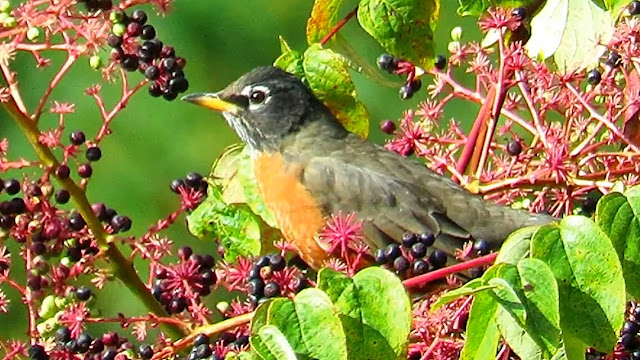American Robins Feasting on Berries
Robins, Grosbeaks, Cardinals, Juncos and various other songbirds partake of an early autumn feast of ripe Walking Stick berries!
Aralia spinosa, commonly known as devil's walkingstick, is a woody species of plants in the genus Aralia, family Araliaceae, native to eastern North America. The various names refer to the viciously sharp, spiny stems, petioles, and even leaf midribs. It has also been known as Angelica-tree.[1]
This species is sometimes called Hercules' club, prickly ash, or prickly elder, common names it shares with the unrelated Zanthoxylum clava-herculis. For this reason, Aralia spinosa is sometimes confused with that species and mistakenly called the Toothache Tree,[2] but it does not have the medicinal properties of Zanthoxylum clava-herculis.
Aralia spinosa is occasionally cultivated for its exotic, tropical appearance, having large lacy compound leaves. It is closely related to the Asian species Aralia elata, a more commonly cultivated species with which it is easily confused.
Aralia spinosa is widespread in the eastern United States, ranging from New York to Florida along the Atlantic coast, and westward to Ohio, Illinois, and Texas. It prefers a deep moist soil.[1] The plants typically grow in the forest Understory or at the edges of forests, often forming clonal thickets by sprouting from the roots.
This tree was admired by the Iroquois because of its usefulness, and for its rarity. The Iroquois would take the saplings of the tree and plant them near their villages and on islands, so that animals wouldn't eat the valuable fruit. The fruit was used in many of the natives' foods. The women would take the flowers and put them in their hair because of the lemony smell. The flowers could also be traded for money.
New HD videos uploaded frequently. Subscribe at: http://www.youtube.com/subscription_c...American Robins Feasting on Berries

Where did you get the information regarding the Native American uses of A. spinosa? I find no such uses in the Native American Ethnobotany Database. Source: http://naeb.brit.org/uses/search/?string=Aralia+spinosa
ReplyDeleteErik
The info was copied from Wikipedia entry in Aralia spinosa
Delete